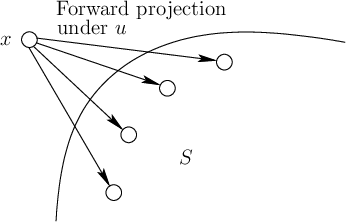
Next: Nondeterministic Dijkstra Up: 10.2.3 Graph Search Methods Previous: 10.2.3 Graph Search Methods
A backward search can be conducted by incrementally growing a plan
outward from ![]() by using backprojections. A complete algorithm for
computing feasible plans under nondeterministic uncertainty is
outlined in Figure 10.6. Let
by using backprojections. A complete algorithm for
computing feasible plans under nondeterministic uncertainty is
outlined in Figure 10.6. Let ![]() denote the set of
states for which the plan has been computed. Initially,
denote the set of
states for which the plan has been computed. Initially,
![]() and, if possible,
and, if possible, ![]() may grow until
may grow until ![]() . The plan definition
starts with
. The plan definition
starts with
![]() for each
for each
![]() and is incrementally
extended to new states during execution.
and is incrementally
extended to new states during execution.
 |
Step 2 takes every state ![]() that is not already in
that is not already in ![]() and checks
whether it should be added. This requires determining whether some
action,
and checks
whether it should be added. This requires determining whether some
action, ![]() , can be applied from
, can be applied from ![]() , with the next state guaranteed to
lie in
, with the next state guaranteed to
lie in ![]() , as shown in Figure 10.7. If so, then
, as shown in Figure 10.7. If so, then
![]() is assigned and
is assigned and ![]() is extended to include
is extended to include ![]() . If no
such progress can be made, then the algorithm must terminate.
Otherwise, every state is checked again by returning to Step 2. This
is necessary because
. If no
such progress can be made, then the algorithm must terminate.
Otherwise, every state is checked again by returning to Step 2. This
is necessary because ![]() has grown, and in the next iteration new
states may lie in its strong backprojection.
has grown, and in the next iteration new
states may lie in its strong backprojection.
For efficiency reasons, the
![]() set in Step 2 may be
safely replaced with the smaller set,
set in Step 2 may be
safely replaced with the smaller set,
![]() , because it
is impossible for other states in
, because it
is impossible for other states in ![]() to be affected. Depending on
the problem, this condition may provide a quick way to prune many
hopeless states from consideration. As an example, consider a
grid-like environment in which a maximum of two steps in any direction
is possible at a given time. A simple distance test can be
implemented to eliminate many states from possible inclusion into
to be affected. Depending on
the problem, this condition may provide a quick way to prune many
hopeless states from consideration. As an example, consider a
grid-like environment in which a maximum of two steps in any direction
is possible at a given time. A simple distance test can be
implemented to eliminate many states from possible inclusion into ![]() in Step 2.
in Step 2.
As long as the consideration of states to include in ![]() is
systematic, as considered in Section 2.2, numerous
variations of the algorithm in Figure 10.6 are possible.
One possibility is to keep track of the cost-to-go and grow
is
systematic, as considered in Section 2.2, numerous
variations of the algorithm in Figure 10.6 are possible.
One possibility is to keep track of the cost-to-go and grow ![]() based
on incrementally inserting minimal-cost states. This leads to a
nondeterministic version of Dijkstra's algorithm, which is covered
next.
based
on incrementally inserting minimal-cost states. This leads to a
nondeterministic version of Dijkstra's algorithm, which is covered
next.
Steven M LaValle 2020-08-14